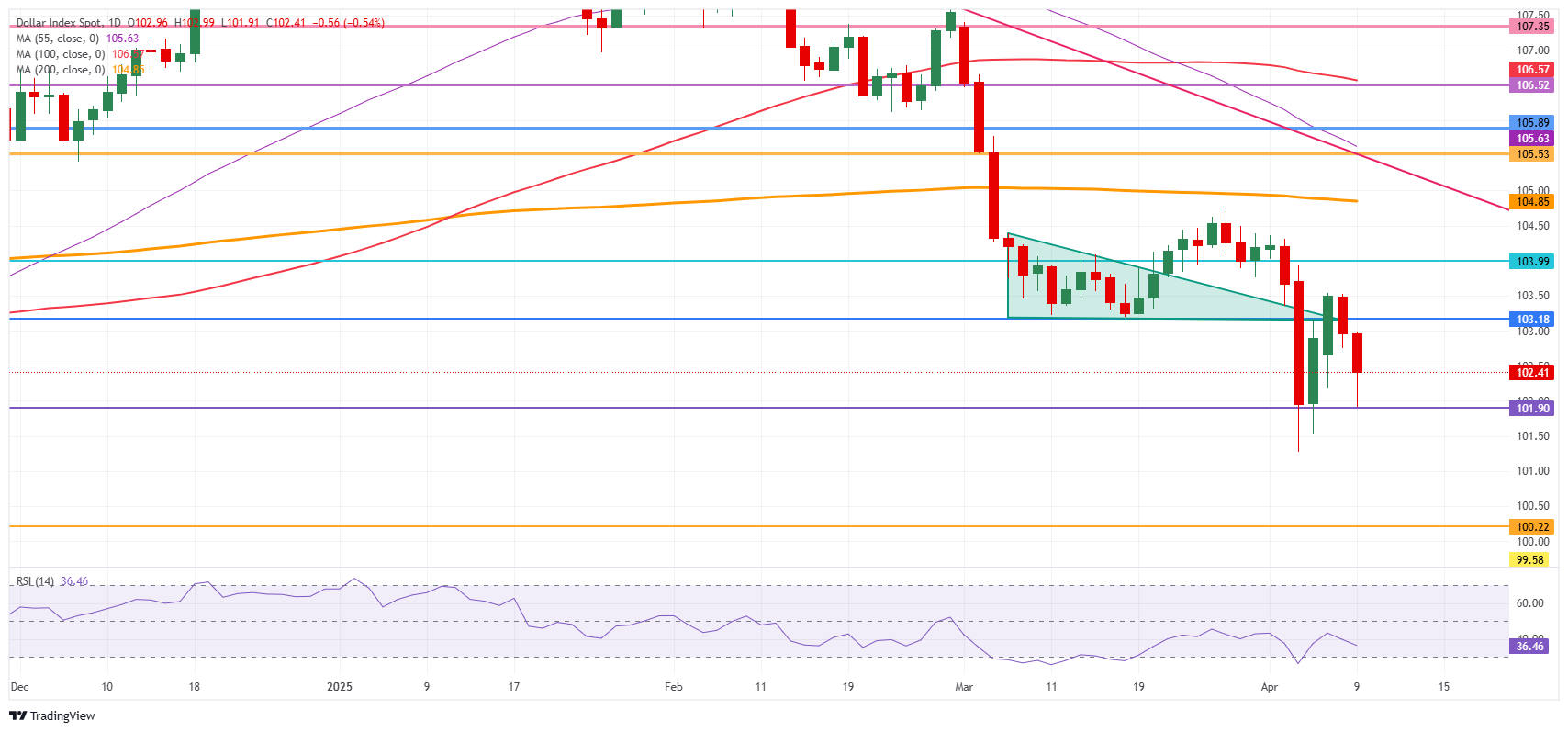US Dollar dives as US tariffs trigger market reaction
- The Greenback edges lower against most major currencies as US tariffs impact markets.
- Asian and European Equities edge lower amid fears of global economic slowdown due to tariffs.
- The US Dollar Index is on the backfoot, though it starts to recover during the European session.
The US Dollar Index (DXY), which tracks the performance of the US Dollar (USD) against six major currencies, extends the previous day’s correction and hovers around 102.30 at the time of writing on Wednesday after testing the 102.00 level in the early Asian session. The tariffs that United States (US) President Donald Trump introduced on Liberation Day are going to take effect this Wednesday. Meanwhile, China and Canada have already vowed to retaliate against these tariffs with countermeasures, increasing fears of a global economic slowdown.
On the economic calendar front, some light data is set to be published on Wednesday ahead of the Federal Open Market Committee (FOMC) Minutes for the Federal Reserve (Fed) monetary policy meeting in March. However, not much is expected from the Minutes, as Fed Chairman Jerome Powell said last week that the central bank will be in a “wait-and-see” mode. Meanwhile, markets are piling in for more interest rate cut bets by the Fed in 2025.
Daily digest market movers: Fed Minutes to leave markets clueless
- China has issued comments that it is set to impose a near 84% tariffs on all US goods starting 10th of April, Bloomberg reports.
- At 11:00 GMT, the Mortgage Bankers Association released its weekly mortgage application numbers. The actual number was a firm jump of 20% in comparison to the previous number of -1.6%.
- At 14:00 GMT, the February Wholesale Inventory data is due. Expectations are for a steady 0.3% growth.
- AT 16:30 GMT, Richmond Fed President Thomas Barkin will speak at the economic club in Washington.
- At 18:00 GMT, the FOMC Minutes from their last meeting in March will be released.
- Equities are sinking lower again after China retaliated on US tariffs.
- The CME FedWatch tool shows the chance of an interest rate cut by the Federal Reserve in May’s meeting surging to 53.5%, compared with only 10.6% a week ago. For June, the chances of lower borrowing costs are 100%, with 55.2% anticipating a 50 basis point (bp) rate cut.
- The US 10-year yields trade around 4.35%, and keep rallying higher while the Fedwatch tool is seeing more rate cut bets being priced in.
US Dollar Index Technical Analysis: More to come
The US Dollar Index (DXY) dipped lower earlier this Wednesday and looks to be bouncing off a pivotal support at 101.90 for now. The question remains, though, that with these tariffs and once US economic data start to turn, the DXY might see more selling pressure come in. That could mean a further weakening of the Greenback in the coming weeks or months, even as the impact of these tariffs will only start to be priced in now.
Looking up, the first level to watch out for is 103.18, which supported the DXY in March and has now become a strong resistance. Above there, the 104.00 round level and the 200-day Simple Moving Average (SMA) at 104.85 come into play.
On the downside, 101.90 is the first line of defense, and it should be able to trigger a bounce as it has been able to hold the recent bearish momentum last week and did its duty again earlier this Wednesday. Maybe not on Wednesday, but in the coming days, a break below 101.90 could see a leg lower towards 100.00.

US Dollar Index: Daily Chart
US-China Trade War FAQs
Generally speaking, a trade war is an economic conflict between two or more countries due to extreme protectionism on one end. It implies the creation of trade barriers, such as tariffs, which result in counter-barriers, escalating import costs, and hence the cost of living.
An economic conflict between the United States (US) and China began early in 2018, when President Donald Trump set trade barriers on China, claiming unfair commercial practices and intellectual property theft from the Asian giant. China took retaliatory action, imposing tariffs on multiple US goods, such as automobiles and soybeans. Tensions escalated until the two countries signed the US-China Phase One trade deal in January 2020. The agreement required structural reforms and other changes to China’s economic and trade regime and pretended to restore stability and trust between the two nations. However, the Coronavirus pandemic took the focus out of the conflict. Yet, it is worth mentioning that President Joe Biden, who took office after Trump, kept tariffs in place and even added some additional levies.
The return of Donald Trump to the White House as the 47th US President has sparked a fresh wave of tensions between the two countries. During the 2024 election campaign, Trump pledged to impose 60% tariffs on China once he returned to office, which he did on January 20, 2025. With Trump back, the US-China trade war is meant to resume where it was left, with tit-for-tat policies affecting the global economic landscape amid disruptions in global supply chains, resulting in a reduction in spending, particularly investment, and directly feeding into the Consumer Price Index inflation.

